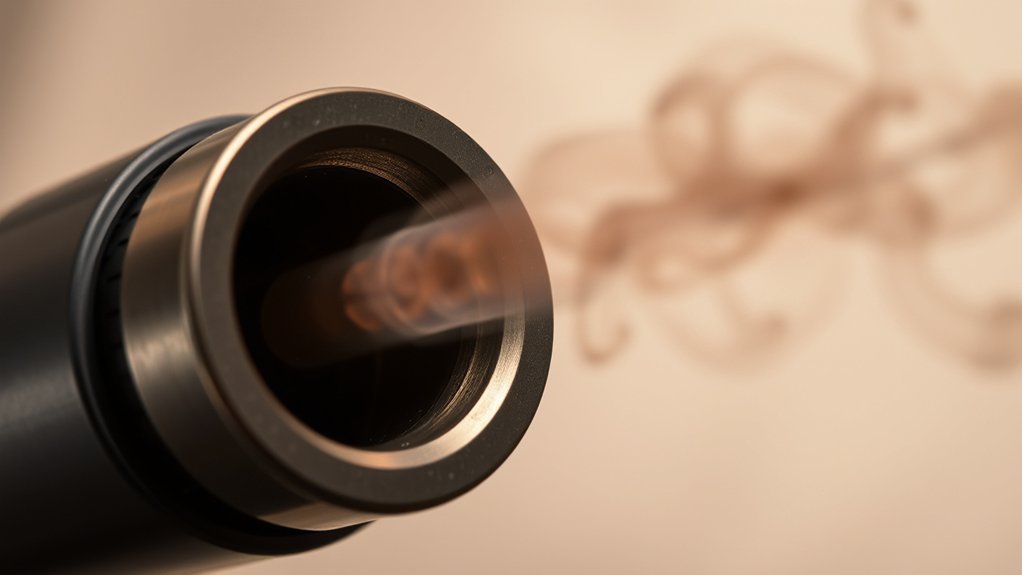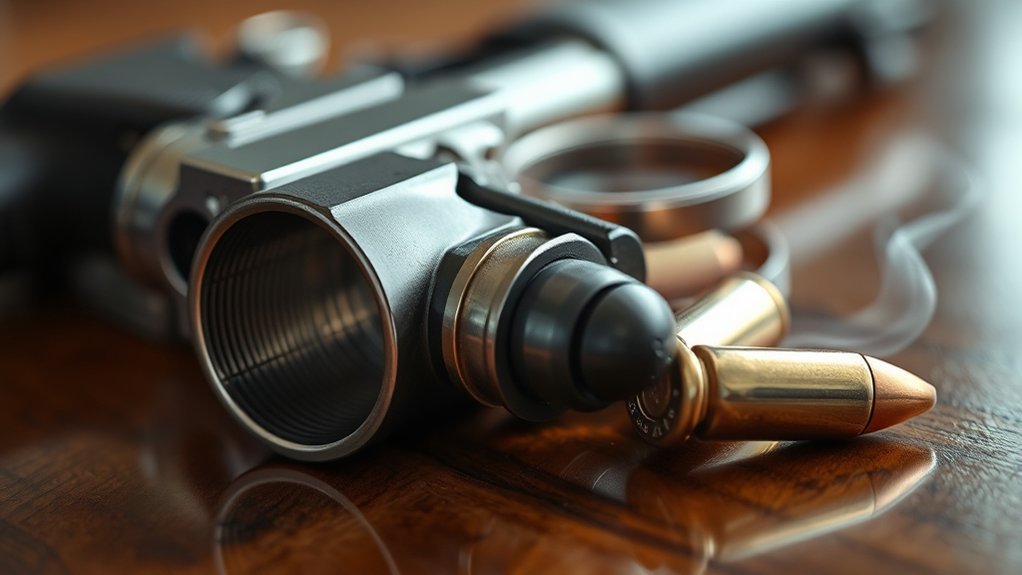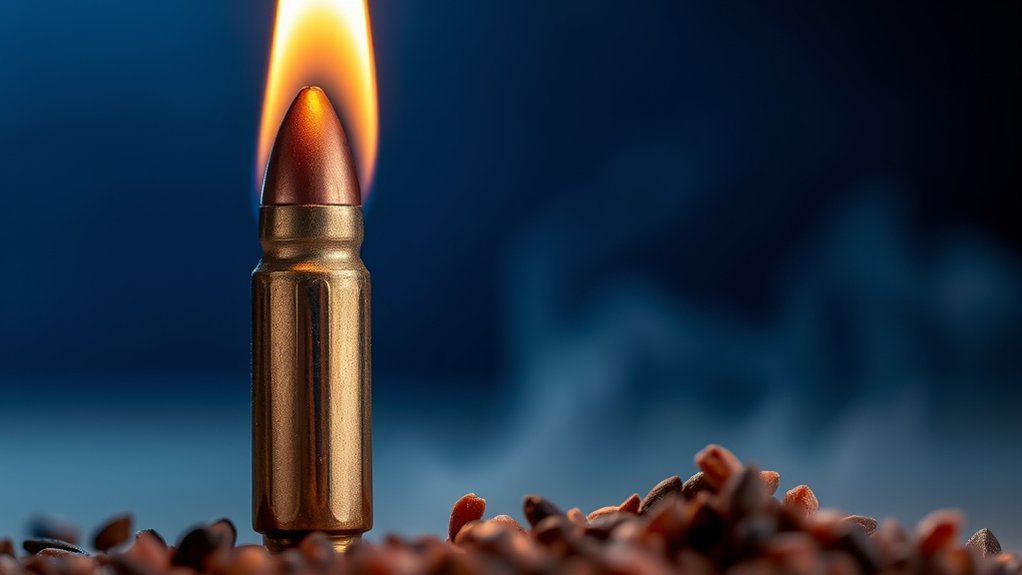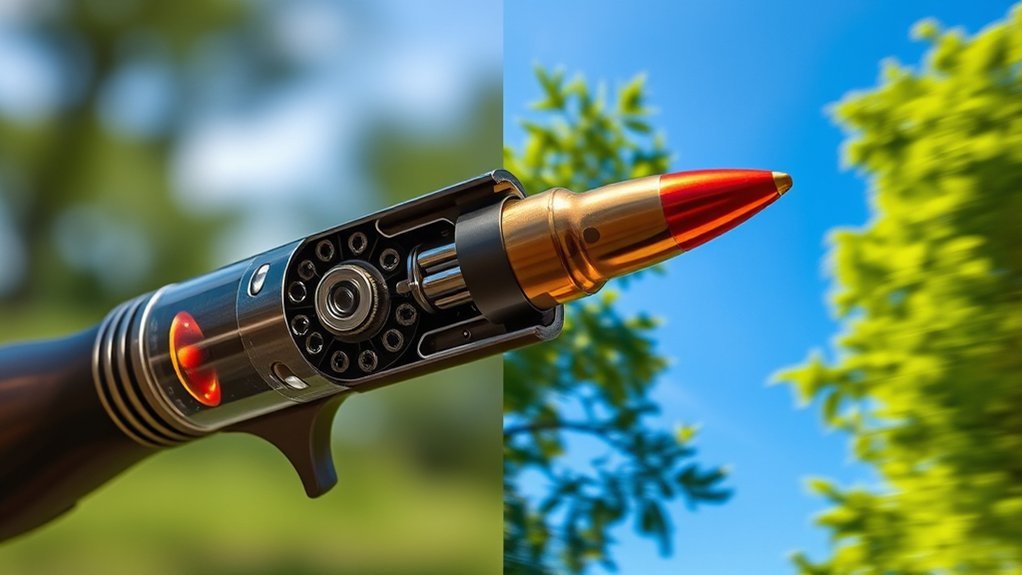When you pull the trigger, a complex sequence of events unfolds within the firearm, known as internal ballistics. This process involves ignition, propellant behavior, and barrel dynamics, all of which set the stage for the bullet’s journey. Once it exits the barrel, external ballistics takes over, with factors like air resistance and environmental conditions influencing its flight path. Understanding both elements is essential for improving accuracy and performance. What happens next might surprise you.
Understanding Internal Ballistics

Understanding internal ballistics involves examining the processes that occur within a firearm from the moment the trigger is pulled until the bullet exits the barrel. When you pull the trigger, the firing pin strikes the primer, igniting the propellant. This rapid combustion generates high-pressure gas that pushes the bullet down the barrel. You should consider factors such as the type and amount of gunpowder, the bullet’s weight, and the barrel’s length, as these greatly influence velocity and trajectory. The interaction between the bullet and barrel also plays a vital role, affecting the bullet’s stability and accuracy. Analyzing these elements allows you to understand how internal conditions impact overall firearm performance and precision during firing.
The Firearm’s Mechanics and Internal Pressure

When you fire a weapon, the ignition of the propellant generates a rapid increase in internal pressure within the chamber. This pressure drives the projectile through the barrel, greatly influencing barrel dynamics and overall performance. Understanding these mechanics is essential for optimizing firearm efficiency and safety.
Pressure Generation Mechanism
As the primer ignites the gunpowder within the cartridge, a rapid chemical reaction occurs, generating high-pressure gases that propel the bullet down the barrel. This pressure generation is vital for effective projectile propulsion. The burning gunpowder releases energy, quickly converting solid matter into gas, which expands in a confined space. This expansion leads to a significant increase in pressure, often exceeding 30,000 psi in modern firearms. The pressure builds until it reaches a threshold, forcing the bullet out of the casing and into the barrel. The design of the cartridge and the type of propellant directly influence the rate of pressure increase and the overall efficiency of the ignition process, affecting accuracy and performance. Understanding these dynamics is essential for optimizing firearm effectiveness.
Barrel Dynamics Impact
The dynamics within the barrel play a vital role in the performance of a firearm, directly influenced by the internal pressure generated during ignition. As you fire, the rapid expansion of gases creates intense pressure, impacting how the bullet travels through the bore. This pressure must be managed to optimize bullet acceleration and minimize distortions. The barrel’s length, diameter, and material properties affect how pressure builds and dissipates. If the barrel flexes or vibrates excessively, it can lead to inconsistencies in bullet trajectory and accuracy. Understanding these interactions is essential for evaluating a firearm’s overall efficiency. By examining barrel dynamics, you can better appreciate how they influence internal ballistics and contribute to the successful operation of a firearm.
Ignition and Propellant Role
While understanding the ignition and propellant role is essential for grasping the intricacies of internal ballistics, it’s the precise interaction between the primer, powder, and the firearm’s mechanics that drives performance. The ignition process begins when the firing pin strikes the primer, igniting the powder. This rapid combustion generates high-pressure gas, propelling the bullet down the barrel.
Key factors influencing this process include:
- Primer Sensitivity: Determines how easily the primer ignites under impact.
- Powder Grain Size: Affects burn rate and pressure buildup.
- Chamber Design: Influences how pressure is managed during firing.
Understanding these elements helps you appreciate how ignition and propellant work together to optimize firearm performance.
The Role of Propellant and Ignition

Understanding the role of propellant and ignition is vital for grasping the intricacies of internal ballistics. The propellant acts as the energy source, undergoing rapid combustion to generate high-pressure gas. This gas expands within the cartridge, driving the bullet forward. The ignition process is imperative; it involves the primer, which initiates combustion when struck by the firing pin. Proper ignition guarantees consistent pressure and velocity, essential for accuracy. You’ll find that variations in propellant type, charge weight, and ignition timing can greatly affect performance. An efficient ignition system assures that the propellant burns uniformly, optimizing gas production. Ultimately, mastery of these elements enhances your understanding of how internal ballistics directly influences the behavior of firearms during discharge.
External Ballistics: The Bullet’s Flight
As the bullet exits the barrel, its flight is influenced by various external factors that dictate its trajectory and performance. Understanding these dynamics is essential for accurate shooting and effective ballistics analysis.
- Air Resistance: The bullet encounters drag, which affects its speed and stability.
- Gravity: This constant force pulls the bullet downward, altering its path over distance.
- Wind: Crosswinds can deflect the bullet, requiring adjustments to aim.
These factors interact continuously, shaping the bullet’s flight from the moment it leaves the muzzle until it reaches its target. By grasping these principles, you’ll enhance your understanding of how external ballistics operates, ultimately improving your shooting precision and effectiveness.
Factors Affecting Bullet Trajectory
The trajectory of a bullet is influenced by a combination of factors that extend beyond just external ballistics. The bullet’s initial velocity, determined by the firearm’s chamber pressure and barrel length, plays a vital role. Additionally, bullet design—such as weight, shape, and material—affects aerodynamics and stability during flight. The angle of elevation at which you fire also greatly alters the trajectory, impacting range and accuracy. Moreover, barrel harmonics can introduce variations in bullet behavior upon exiting, leading to deviations from the expected path. Understanding these elements allows you to predict and adjust your aim for ideal performance, ensuring a more precise shot. Ultimately, mastering these factors enhances your shooting accuracy and effectiveness.
The Impact of Wind and Weather Conditions
While you might focus on bullet design and initial velocity when aiming for accuracy, wind and weather conditions can greatly alter your shot’s trajectory. Understanding these factors is essential for precision shooting.
Wind and weather significantly influence your shot’s trajectory, making their understanding crucial for precision shooting.
- Wind Drift: Lateral wind can push your bullet off course, causing significant deviation from your intended target.
- Temperature and Humidity: Changes in air density affect bullet flight; higher temperatures and humidity can increase bullet velocity and drop.
- Elevation: Altitude impacts both air density and wind patterns, requiring adjustments to your aim.
Measuring Ballistic Performance
When you measure ballistic performance, two critical factors come into play: velocity and energy. These metrics directly impact the accuracy and consistency of your ammunition. Understanding how they interact will help you optimize your shooting experience.
Velocity and Energy
Understanding velocity and energy is essential for accurately measuring ballistic performance, as these factors directly influence a projectile’s behavior both inside the firearm and during its flight. Velocity refers to the speed at which a projectile travels, while energy quantifies its capacity to do work upon impact.
- Higher velocity often correlates with increased accuracy and effective range.
- Energy is vital for determining the projectile’s stopping power and terminal performance.
- Both factors are influenced by variables like barrel length, powder charge, and projectile weight.
Accuracy and Consistency
Achieving high accuracy and consistency in ballistic performance is essential for any shooter aiming to enhance their effectiveness. To measure these parameters, you can evaluate factors such as shot dispersion, group size, and repeatability. The following table summarizes key metrics for evaluating accuracy and consistency:
| Metric | Definition | Importance |
|---|---|---|
| Shot Dispersion | The spread of shots on a target | Indicates control and precision |
| Group Size | The diameter of the tightest shot group | Reflects overall accuracy |
| Standard Deviation | Variation in shot placements | Measures consistency |
Practical Applications and Implications for Shooters
While many shooters focus primarily on external ballistics for accuracy at range, understanding the implications of internal ballistics can greatly enhance your overall shooting performance. Internal ballistics involves the events that occur within the firearm before the bullet exits the barrel, and mastering this area can lead to improvements in your shooting outcomes.
Mastering internal ballistics can significantly elevate your shooting performance and accuracy.
- Optimal Reloading Techniques: Tailoring your powder selection and charge can reduce variations in muzzle velocity.
- Barrel Dynamics: Understanding how pressure and temperature affect barrel harmonics can help minimize shot dispersion.
- Component Matching: Using compatible components—brass, bullets, and primers—can yield more consistent ignition and performance.
Conclusion
In mastering both internal and external ballistics, you’re not just honing your shooting skills; you’re wielding knowledge akin to an archer aligning their arrow with the wind. Understanding the dynamics within your firearm enhances ignition and pressure, while grasping the nuances of bullet flight guarantees precision. Just like Odysseus steering the seas, your ability to adapt to various conditions can make all the difference in hitting your mark. Embrace these fundamentals to elevate your shooting prowess.

